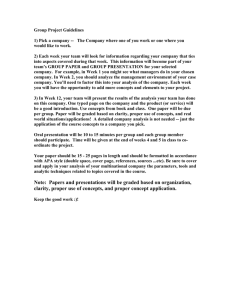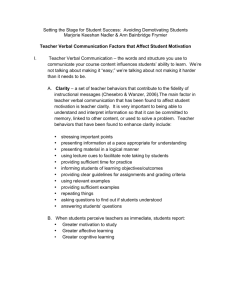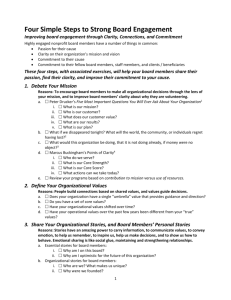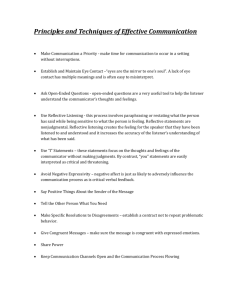CLARITY OF EXPRESSION IN INTERPERSONAL COMMUNICATION*
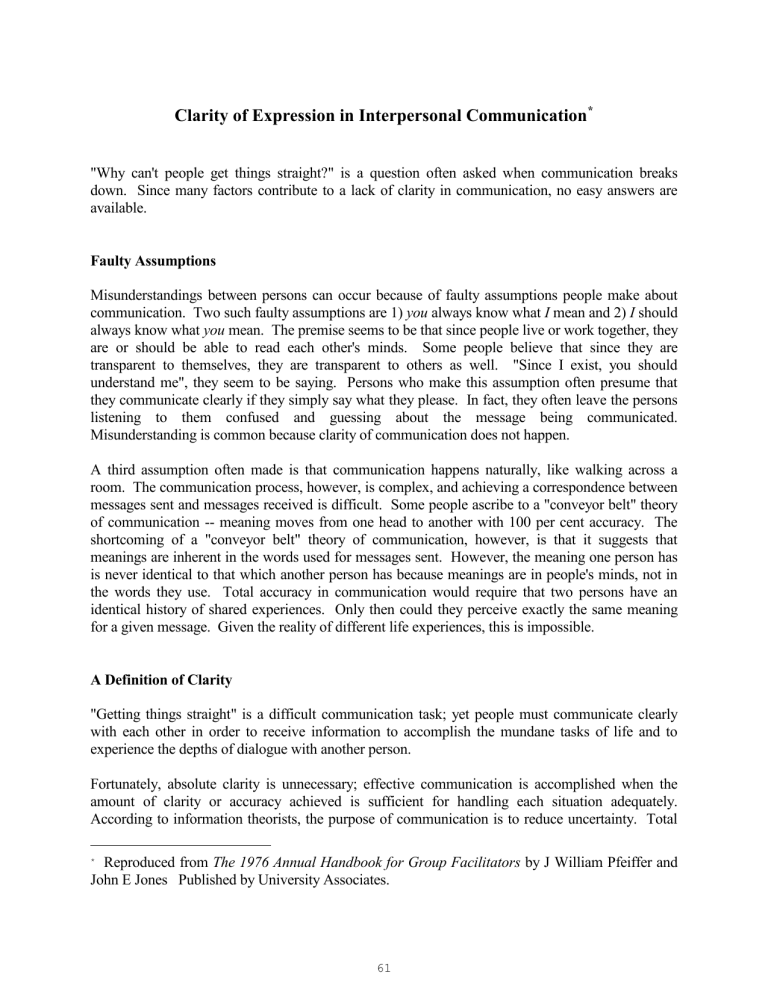
Clarity of Expression in Interpersonal Communication
*
"Why can't people get things straight?" is a question often asked when communication breaks down. Since many factors contribute to a lack of clarity in communication, no easy answers are available.
Faulty Assumptions
Misunderstandings between persons can occur because of faulty assumptions people make about communication. Two such faulty assumptions are 1) you always know what I mean and 2) I should always know what you mean. The premise seems to be that since people live or work together, they are or should be able to read each other's minds. Some people believe that since they are transparent to themselves, they are transparent to others as well. "Since I exist, you should understand me", they seem to be saying. Persons who make this assumption often presume that they communicate clearly if they simply say what they please. In fact, they often leave the persons listening to them confused and guessing about the message being communicated.
Misunderstanding is common because clarity of communication does not happen.
A third assumption often made is that communication happens naturally, like walking across a room. The communication process, however, is complex, and achieving a correspondence between messages sent and messages received is difficult. Some people ascribe to a "conveyor belt" theory of communication -- meaning moves from one head to another with 100 per cent accuracy. The shortcoming of a "conveyor belt" theory of communication, however, is that it suggests that meanings are inherent in the words used for messages sent. However, the meaning one person has is never identical to that which another person has because meanings are in people's minds, not in the words they use. Total accuracy in communication would require that two persons have an identical history of shared experiences. Only then could they perceive exactly the same meaning for a given message. Given the reality of different life experiences, this is impossible.
A Definition of Clarity
"Getting things straight" is a difficult communication task; yet people must communicate clearly with each other in order to receive information to accomplish the mundane tasks of life and to experience the depths of dialogue with another person.
Fortunately, absolute clarity is unnecessary; effective communication is accomplished when the amount of clarity or accuracy achieved is sufficient for handling each situation adequately.
According to information theorists, the purpose of communication is to reduce uncertainty. Total
* Reproduced from The 1976 Annual Handbook for Group Facilitators by J William Pfeiffer and
John E Jones Published by University Associates.
61
accuracy in communication would lead to an absence of uncertainty. However, uncertainty can never be totally eliminated. Accurate or clear communication, then, is designed to reduce uncertainty in a given situation to a point where necessary understanding can occur.
Certain practical principles and guidelines for reducing uncertainty and increasing the accuracy and clarity in inter-personal communication can be suggested. To achieve greater clarity in speaking, the individual should have the desire to do so and want to understand the communication process more completely. The communicator can try to analyse and shape his message according to the following factors: sending and receiving, the communication context, encoding a message and communication channels. Of course, the degree of clarity achieved in a given situation is likely to result from the combined effects of several of these factors. Since communication is a process, the factors being considered are inter- related, making it difficult to differentiate one from another.
Sending and Receiving
Several principles and guidelines are observable in any attempt to send a clear message from one person to another. These guidelines can be seen in terms of pictures, attitudes, skills, and the frame of reference.
Pictures : A person needs to have a clear picture of what he hopes to communicate to another individual. The preacher needs a proposition to help him know what he is trying to accomplish with a sermon. The teacher needs instructional objectives to help him know what he wants his pupils to learn. The administrator needs both short- and long-range objectives to help him plan organisational goals and interpret them to his colleagues. Well-stated goals or objectives aid the effective communicator in developing a clear picture of what he wants to say.
The first guideline is particularly valid when dealing with complex, ambiguous, or vague topics. If a topic or idea is unclear to the person sending the message, its lack of clarity is likely to be magnified by the person trying to understand it. Although there are times when a person may find inter-personal communication helpful in clarifying the pictures in his own head, it is imperative that the communicator first be clear about his ideas before he attempts to convince or influence others, give data, or share feelings.
Attitudes : Accuracy in communication varies with the attitudes of the communicators toward their topics. If a person's attitudes are very positive or very negative, the resulting communication tends to be less accurate. Indeed, persons often organise data according to their biases.
Communication clarity is also influenced by the attitudes of the communicators toward each other.
It seems reasonable that communication between people who respect or love each other would be more accurate. However, research indicates that the accuracy is inversely correlated with either positive or negative attitudes that the communicators hold toward each other. Thus, an analysis of the extent of one's positive or negative attitudes toward the topic and toward the listener is important for clarity and accuracy of communication.
62
Communication skills : Clarity of communication is also influenced by the extent to which those listening and those sending are aware of their communication skills. It is possible to evaluate the assumptions one holds about his ability to communicate messages. Persons with careless speech communication habits are often convinced that they are successful communicators because they are able to open their mouths and utter a stream of words. Actual skills in interpersonal communication, however, are quite different. An accurate assessment of one's own communication weaknesses and strengths is important. Often, strengths can be maximised and weaknesses improved. One person may have a sparkling personality that aids him in communication. Another may have a way with words. Yet another may be able to communicate in such a way that others feel he understands them.
The communicator should also try to assess the listening skills of the person receiving the message.
Good "hearing" is not necessarily good "listening". As listening is an active rather than a passive process, people's poor listening habits often take the form of day dreaming, defensiveness, inattention etc.
Psychological Frame of Reference :
Because communication is a function of shared or common meanings, meaning does not occur simply because words are spoken. Words have no meaning in and of themselves.
Meaning is what people attribute to words; meanings lie within the experiences and feelings of persons. Thus meanings are within people.
Each person is unique. What he is has been determined by his individual experiences and choices in or with his family, friends, school, church, and culture. Each person has his own set of perceptions, thoughts, feelings, and behaviors. This uniqueness has a profound impact upon the success or failure of communication.
It is impossible to know what another person is sensing or feeling. Because a listener can only guess about the communicator's meaning, it is essential that the person speaking avoid basing his communication on unexamined assumptions about that person.
To assess what he is communicating, the sending person needs to know the psychological frame of reference of the person receiving the message. How does the listener see, feel, and act with respect to others and their world? The psychological frame of reference of a child is quite different from that of an adult. Persons from cities see life differently than do people from the country. Some people prefer to quench their thirst with Pepsi-Cola rather than 7-Up; others choose Dr. Pepper.
Some people like Henry Kissinger; others intensely dislike him.
People respond quite differently to the words they hear. One person may react warmly to the words
"Jesus saves", while another person may become angry and hostile, and yet another may be indifferent and display no strong sentiment. Indeed, what is clear and rational to one person may seem vague and ridiculous to someone else.
A person can increase the clarity of his communication by constantly trying to place himself inside the psychological framework of the other person. He must try to see the communicative situation
63
from the listener's point of view. If the person communicating understands the other person, he can make his communication more relevant to this person's self-understanding and needs.
Communication Context
A second set of factors affecting the clarity of communication is the context in which communication occurs. Is the setting an office, someone's home, or the golf course?
Communicating with a professor in his office is altogether different from communicating with a friend at the bowling alley. The "rules" in the two situations are distinctly different.
The context of communication is important in determining the amount of accuracy needed or possible between persons in a given situation. How much clarity can be achieved is somewhat determined by the person's communication skills, the number of communication channels available to the person sending, how much repetition he can incorporate into his message, and the nature of the relationship between the persons communicating. Attempting to communicate with a person in another room presents more difficulties for the clarification process than does speaking face-to-face.
In short, the speaker needs to develop a realistic expectation for the degree of clarity obtainable in a given context.
Encoding a Message
In order to make ideas clear, an individual must encode his message in order to reduce the amount of uncertainty the other person experiences in hearing that communication. Encoding is the process of translating ideas into a message appropriate for delivery. Once ideas are encoded into messages, they become the potential information that can reduce ambiguity in the other person's mind and produce a clearer picture. There are seven principles for increasing the accuracy and clarity of the message persons use to communicate.
1. Principle of Relevance
Make the message relevant in the terms of the listening party. The most difficult task related to encoding a message is to assemble it in such a way that the words used accurately reflect the picture one intends and, at the same time, fall within the other person's psychological frame of reference. If a listener is to comprehend the sender's message, he must be able to relate the information he is receiving to what he already knows. Therefore, it is important that the message be presented in a context that says to the listener: "This is important and significant for you". Using the words of the listening person rather than one's own to encode a message can do this. Such a strategy in communication requires adaptability and flexibility in communication behaviour, so that, whether speaking to a child, a teenager, an adult, or persons from different cultural and subcultural backgrounds, the communicator employs appropriate behaviours for sending a clear message.
Just as the encoding of a message should be relevant to the person to whom one is speaking, so should it be appropriate to the situation or the context. The content of a conversation in the privacy of a home is not necessarily appropriate for a discussion at a church committee meeting. Even if
64
the topic were the same in both situations, the message would very likely be encoded quite differently.
2. Principle of Simplicity
Reduce ideas to the simplest possible terms. The communicator should employ as few words as possible to communicate his ideas to a listener. Simplicity of language and economy of words are helpful in facilitating clarity of communication. Generally, the simpler the words, the more likely they are to be understood. However, simplicity really relates to the experience of the person receiving the message. What is simple to one person is complex to another. Theological material that is easily understood by the student of theology may seem quite complicated when presented to the layman in a Sunday morning sermon. The effective communicator calculates the extent to which material must be simplified if it is to be understood by those listening, and he uses the principle of simplicity to make sending messages more successful.
3. Principle of Definition
Define before developing, explain before amplifying. Even simple terms can be unclear. Where would a person go, for example, if someone said, "I'll meet you at the side of the building"? Terms more complicated than "side" increase the need for definition and explanation. The use of jargon also creates problems of clarity for those not acquainted with the words. Unfamiliarity with jargon may cause a person to become confused and frustrated in his efforts to understand. He may even stop trying. Unfamiliar or exceptional terms or concepts need to be defined and explained before they are used to make communicator's message as clear as possible.
4. Principle of Structure
Organise a message into a series of successive stages. Texts on public speaking emphasise the importance of making apparent the order or structure of a message. A well-organised speech, it is said, will increase the audience's understanding. However, there is little research evidence to support such a contention, especially in regard to face-to- face dialogue. Indeed, most people will structure the message in accordance with their own patterns of thinking even as they listen, regardless of how well a message is organised.
What is important is the clarity of thought and the expression of individual parts. In interpersonal communication it is probably best to develop one idea at a time. A message can be "packaged" into a series of stages, with one stage completed before the next is introduced.
Furthermore, the communicator can help the person listening by not overloading him with information. When persons are asked to comprehend too much, they tend to forget or become confused. By developing one idea at a time and taking one step at a time, the person speaking can facilitate accuracy in communication.
65
5. Principle of Repetition
Repeat the key concepts of the message. The principle of repetition is important. Very important.
The words "very important" were repetitive. They repeated the idea of the second sentence in a slightly different manner in order to make the concept clearer. Repetition is particularly important in oral communication, where words are spoken only once. Obviously a communicator should not repeat everything he says since it would bore the listener. However, the person speaking needs to use enough repetition to ensure clear reception of his ideas. Some possible strategies: (a) repeating key ideas, (b) restating difficult ideas, (c) recycling ideas wherever feedback indicates they are weak or misunderstood, and (d) using examples, synonyms, analogies, or periodic summaries. In short, a person should use intentional repetition in his attempts to achieve clarity.
6. Principle of Comparison and Contrast
Relate new ideas to old ideas; associate the unknown with the known. The principle of comparison and contrast is essential to the achievement of clear communication, as understanding comes most often through association - the perception of similarities and differences among objects, events, and people. A person can understand a new, unknown idea more clearly if he is able to relate it to an old, known one.
Discriminating between those elements that rightfully belong to an idea and those that do not will help a listener understand a concept. Comparison helps individuals to identify the similarities in two or more ideas. Contrast helps to point out the differences in two or more ideas. When accurate discriminations occur, clarity in communication emerges: the sharper the discrimination, the greater the clarity.
Helpful devices for presenting comparisons and contrasts include the use of models, metaphors, analogies, and explanations.
7. Principle of Emphasis
Focus on the essential and vital aspects of the communication. Since the transitory nature of interpersonal communication makes it highly susceptible to loss of information, attention should be given to the essential and vital aspects of a message. Communication goals and key points should be sharply focussed so as not to submerge the message in details and make it vague, ambiguous, and blurred. The impact of the significant points of a communication can be heightened by speaking louder using a different tone of voice, pausing, or using various other techniques to captivate the listener. Reinforcing and underscoring ideas help in developing such impact. For example: this last principle is an important one --remember it and use it.
Communication strategies based on these principles for developing or sending a message will result in a more accurate correspondence of ideas between persons.
66
Communication Channels
Once a message is constructed for sending to another person, it must be sent through a communication channel. Several factors related to communication channels affect clarification in the speaking-listening process. Four of these are discussed here.
Channels Available : An important aspect of communication that affects accuracy and clarity is the number of channels available for sending a message. For example, in a letter only one channel -- the written word -- is in use. Face-to-face interaction, however, utilises several channels, e.g., body tension, facial expressions, eye contact, hand and body movements, relative positions of each person, vocal sounds accompanying a verbal message, etc.
To communicate clearly, a person should be aware of the various channels available to him and utilise as many of them as possible. When messages are sent through more than one channel, repetition is increased. As repetition increases, uncertainty is reduced, and the chances for clarity are increased. It is important, however, that whenever multi-channel communication occurs, the messages are consistent across all channels or the results will be confusing for the listener.
Feedback : An awareness and use of feedback is important to the communicator. Feedback, which is a term from cybernetic theory, is an essential element in any control process. This phenomenon can be observed in the operation of a self-adjusting camera in which a built-in light meter measures the amount of illumination in the environment and automatically adjusts the camera accordingly. In a comparable manner, feedback can be used to correct and adjust meanings and thus increase communication clarity. A person sending a message should elicit feedback following his communication attempts in order to determine whether the picture received was the one transmitted. On the basis of this feedback, the next step in the communication process can be taken. In the same way that communication clarity can be increased by using a variety of available channels, a number of feedback channels can also be an aid to accuracy.
Noise : Communication accuracy is affected by "noise", a term frequently used to refer to any disturbance that interferes with the sending of a message. Although noise may occur in almost any aspect of the communication process, such interference appears often as an obstruction in the channel between two interacting persons. The interfering noise may be other people talking, the whine of a vacuum cleaner, or the sound of a lawn mower coming through an open window. The greater the noise, the more difficult it becomes to communicate clearly. For this reason it is important for the communicator to find ways of eliminating or reducing sources of distracting noise.
Speed and Pacing : Clarity of communication is related to how much information a channel can carry and a listener can receive at one time. Because the oral channel requires those listening to depend heavily on their memories for comprehension, it is less effective than other channels for handling large amounts of verbal information. Effective lecturers know that it is the rare audience that can absorb more than one or two new ideas. In contrast, the written channel can carry much more verbal information, as it allows individuals to reconsider the material. Therefore, the speed of oral communication must be determined by the listening person' rate of comprehension. The
67
communicator should pace his message according to the information-processing capacities of the channel and the hearers.
A Summary of Guidelines
A person wishing to achieve greater clarity in his interpersonal communication should find the following guidelines helpful. The communicator seeking to improve his communication clarity should:
1. Have a clear picture of what he wants the other person to understand.
2. Analyse the nature and magnitude of his attitudes toward both the topic and the person with whom he is communicating.
3. Assess his own communication skills and those of the person listening.
4. Seek to identify himself with the psychological frame of reference of the person receiving his ideas.
5. Develop a realistic expectation for the degree of clarity obtainable in a given context.
6. Make the message relevant to the person listening by using that person's language and terms.
7. State his ideas in the simplest possible terms.
8. Define before developing and explain before amplifying.
9. Develop one idea at a time, take one step at a time.
10. Use appropriate repetition.
11. Compare and contrast ideas by associating the unknown with the known.
12. Determine which ideas need special emphasis.
13. Use as many channels as necessary for clarity.
14. Watch for and elicit corrective feedback in a variety of channels.
15. Eliminate or reduce noise if it is interfering.
16. Pace his communication according to the information-processing capacities of the channel and the person listening.
"I know you believe that you understand what you think I said, but I am not sure that you realise that what you heard is not what I meant".
What is clear to you is clear to you and not necessarily to anyone else.
[
]
68
